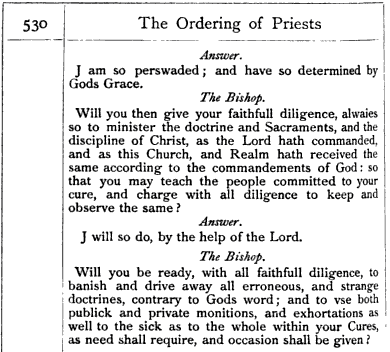Ordain

When Du Vernet mentions that a man is “ordained”, it means that he has undergone the Anglican ceremony that makes him into a spiritual leader in the church. In the Anglican Church, the ordination service is a rite that imparts the spiritual power to serve as a minister, whether as an archdeacon or priest. The Book of Common Prayer provides the directions and materials for the ordination service, with the rite following five main parts: the presentation of the candidates; the litany; the ordination Mass; the ordination of deacons after the epistle; the ordination of priests after the gospel. The idea of women being ordained as priests is still controversial among some members of the worldwide Anglican Communion.
The Rite: A General Description
The first part of the service is the presentation of the candidates for the ministerial offices. The candidates stand before the bishop while their names are called, with the attending archdeacon then presenting them to the bishop. The litany, a form of prayer, then begins. During this time everyone kneels but the candidates, who instead lie prostate on the ground for the litany’s duration. The litany is followed by the beginning of the Communion ritual, including readings from the gospels.
After the gospel readings conclude, those who are to be ordained as priests kneel in a semi-circle around the bishop while the bishop reads out the responsibilities of their new roles. The bishop then kneels and recites the Veni Creator, a Christian hymn. Everyone but the candidates rise after the first verse. Each candidate comes in turn to kneel before the bishop who lays their hands on the candidates’ heads, saying “receive the Holy Ghost.” Other priests then follow and lay their hands on the candidates’ heads but say nothing. The bishop proceeds to give the candidates several items. The rite concludes with the priests receiving the bread and wine of Holy Communion.
Significance
In what is known as “episcopal” Christian theologies, a bishop entrusts ministers with their spiritual authority and theological legitimacy. In the Anglican church, bishops are believed to be part of an unbroken lineage from the original apostles themselves, the earliest followers of Jesus Christ. Known as the apostolic succession, this lineage is perpetuated through the laying of hands during the ordination of bishop, although just how literally this lineage is understood varies greatly within the Anglican church itself. For some Anglicans, apostolic succession must pass from man-to-man, leaving women without official clergy roles in the church.
In the nineteenth century the “low church” group of the Anglican church (of which Du Vernet was a part) put less emphasis on the importance of apostolic succession than the “high church” group. According to the high church, apostolic succession guaranteed the authenticity of the Anglican church and its ministry since only a bishop within the succession could perform valid ordinations, and only bishops and priests ordained by bishops in the apostolic succession can validly celebrate (or “confect”) several of the other sacraments like the Eucharist (the Holy Communion). Jeremiah Johnston, a Swampy Cree man, once ordained a priest, could thereby claim a lineage back to Jesus himself.